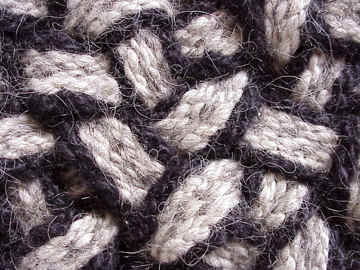A small knotted sample from alpaca yarn and lurex was knotted to assure me the final project was feasible (sample R1)
On my journey through the first half of the COE, I was introduced to very heavy fibers and resulting yarns. but the limits of the first half still left much to explore. Rope will be a future study for me but starts here with amking a knotting yarn strong enough here to quality for rope.
From the fibers I knew to be available and possibly suitable for the project, I decided on Yak top. black and mottled grey were the two colors available (sample R2). Camel hair was lacking in luster and not the color I wanted. I started with the grey, spinning a tightly twisted Z of about 8 threads per inch. I should have sampled the black before finishing the grey singles because the black wanted to spin to about 5 threads per inch (sample R3). I also decided that a lighter thread with the grey and black would look good. I ordered some white Karakul. Even the white wool comes with either brown or black hairs interspersed (sample R4). The Karakul easily spun to about 5 threads per inch (sample R3). I decided to use the grey in very limited quantity to keep the finished diamter of the final yarns similar. there was no need to be exact. It would really be acceptable if they were different diameters entirely as many knots call for different diameter cords to be used together. The way I pictured the final matt would require the yarns to be similar.
After all the singles were spun I sampled different plies to see which would give the desired results (sample R5). The yarn needed to be strong, not too smooth, evenly balanced, and of a diameter of about 1/2 inch. I charted and calculated the pattern for the knot, based on the finished size of the rug. A combination of yarns needed to be packed together to make a flat three inch width. The two by two four ply suited this combination. Because of the square character finished yarn, it was conducive to sewing into a homogenous flat mat. When all the samples were packed together next to each other I decided to try the black, grey/white, white combination.
The black and the grey singles were spun on a flyer wheel with a scotch brake, ratio 4:1. This wheel has a large orifice option and large hooks. it was still difficult to get the tightly twisted singles to feed onto the bobbins. The Karakul was spun on a bulky wheel, bobbin driven, ratio 3:1. The first layer on the bobbin would wind on smoothly and easily. The second layer had to be wound on by hand. Care was taken to keep the twist constant.
After the singles were rolled into balls they were all plied on the bulky wheel, first in an S with over twist. Even on the bulky the yarns had to be rolled onto the bobbin by hand. Very slow. Precaution had to be taken to keep the singles from kinking and not plying evenly. These two plies were then also rolled into balls for their final plying. The final ply was Z twist and balanced. It was done in the same method as the first fold. Although it easily fit through the orifice and eyes of the bulky spinner the stiffness of the yarn did not allow it to draw onto the bobbin. The final ply was also rolled onto the bobbin by hand. To have the longest continuous lengths, I always filled the bobbin as tightly and fully as possible.
In order to knot the rug, I first marked the main intersections of the knot on a cardboard cutting board. Using one of the center yarns I very loosely tied the knot. The other yarns were then carefully and tediously threaded next to the original. It was important to keep them in order and flat. The inside curves use very much less yarn than the outside curves. For stability all the yarn were stitched together to keep them flat. This also improves the wearing ability of the final rug.
Because of the yardage required and the complexity of the know the yarn had to be spliced in a few places. Tradition rope splicing is not a art I have any expertise in and I had to sew the ends together where necessary. These were the most difficult to conceal. If all the sewn ends were on one side of the rug, of course it would then be a one sided rug. This was not my intent. Care was taken to hide the joins and intersperse them, making a two sided rug.
 |
Black yak, mottled grey yak and a white Karakul fleece were chosen for the project for their strength, weight and color. They were spun into singles of about 8 threads per inch in a Z twist. The singles were as tightly twisted as control would allow. They were plied in a S then back again into a four ply Z twisted rope.
In order to knot the rug, I first marked the main intersections of the knot on a cardboard cutting board. Using one of the center yarns, I very loosely tied the knot. The other yarns were then carefully and tediously threaded next to the original. For stability all the yarn were stitched together to keep them flat.
Because of the yardage required and the complexity of the knot the yarn had to be spliced in a few places. Care was taken to hide the joins and intersperse them, making a two sided rug.
The mat can be hand washed in a tub of lukewarm water with Ivory liquid. Use a vinegar rinse or moth proofing solution. Lay the rug flat to dry and remember to turn often.
Close-up of rug detail.![]()
 |